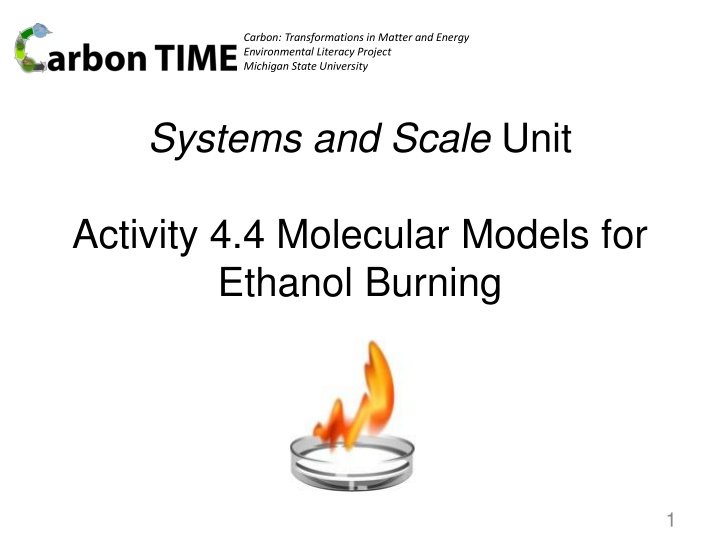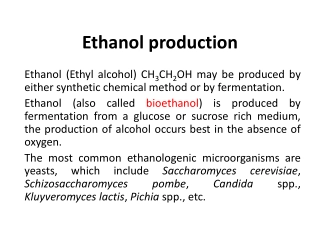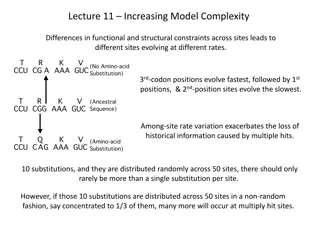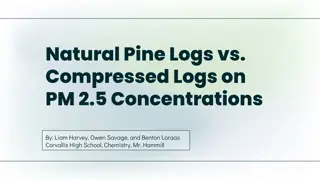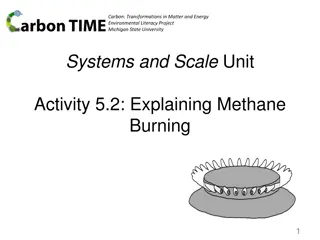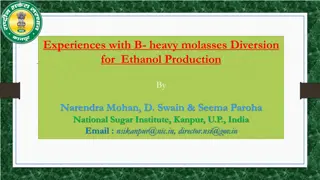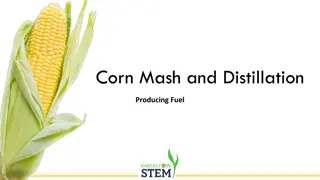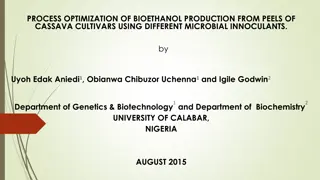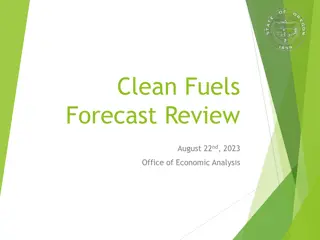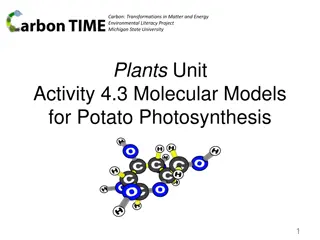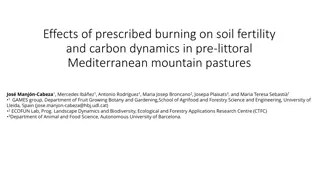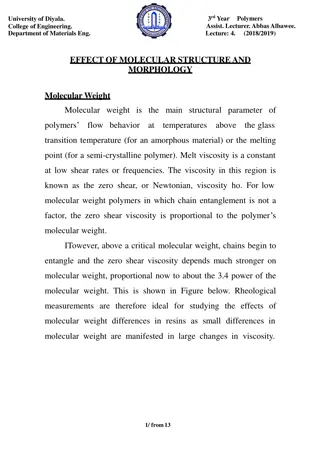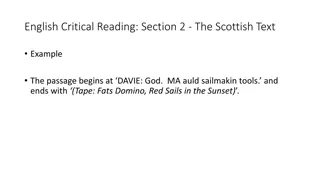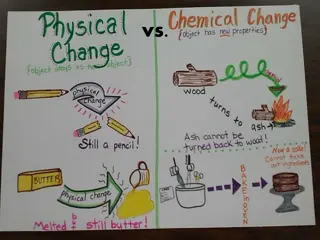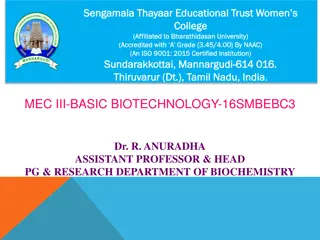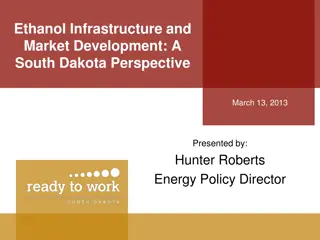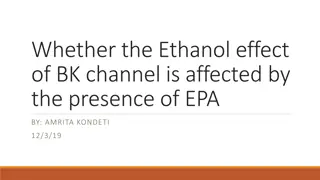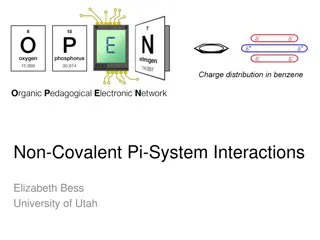Molecular Models for Ethanol Burning - Investigating Chemical Changes
This project delves into the molecular models for ethanol burning, exploring the hidden chemical changes that occur during combustion. Students use a reading strategy to uncover the mysteries of chemical transformations on a molecular scale, linking atoms and energy units to understand the reactants and products involved in the process.
Download Presentation

Please find below an Image/Link to download the presentation.
The content on the website is provided AS IS for your information and personal use only. It may not be sold, licensed, or shared on other websites without obtaining consent from the author.If you encounter any issues during the download, it is possible that the publisher has removed the file from their server.
You are allowed to download the files provided on this website for personal or commercial use, subject to the condition that they are used lawfully. All files are the property of their respective owners.
The content on the website is provided AS IS for your information and personal use only. It may not be sold, licensed, or shared on other websites without obtaining consent from the author.
E N D
Presentation Transcript
Carbon: Transformations in Matter and Energy Environmental Literacy Project Michigan State University Systems and Scale Unit Activity 4.4 Molecular Models for Ethanol Burning 1
Unit Map You are here 2
Molecular Models for Ethanol Burning Your investigation left some unanswered questions. Read to find out about a tool scientists use to explain things they cannot see using the Questions, Connections, Questions Reading Strategy. 3
Whats the hidden chemical change when ethanol burns? ? Oxygen Carbon Dioxide Water Ethanol 4
How Atoms Bond Together in Molecules Atoms in stable molecules always have a certain number of bonds to other atoms: Oxygen atoms do NOT bond to other oxygen atoms if they can bond to carbon or hydrogen instead. Chemical energy is stored in bonds between atoms C-C and C-H bonds are high energy bonds C-O and H-O bonds are low energy bonds 7
Making the Reactant Molecules: Ethanol and Oxygen Complete Steps 1-3 in Part B of your worksheet. 8
Photo of reactant molecules: C2H5OH (ethanol) and O2 (oxygen) Start by making the molecules and energy units of the reactants and putting them on the reactants side, then rearrange the atoms and energy units to show the products. Chemical change Ethanol Oxygen Reactants Products Remember: Atoms last forever (so you can rearrange atoms into new molecules, but can t add or subtract atoms). Energy lasts forever (so you can change forms of energy, but energy units can t appear or go away) 9
Important: When you are finished constructing the reactants, put all extra pieces away. 10
Rearranging the atoms to make product molecules: Carbon Dioxide and Water Complete Steps 4 and 5 in Part B of your worksheet. 11
Photo of product molecules: CO2 (carbon dioxide) and H2O (water) Start by making the molecules and energy units of the reactants and putting them on the reactants side, then rearrange the atoms and energy units to show the products. Water Chemical change Carbon dioxide Products Reactants Remember: Atoms last forever (so you can rearrange atoms into new molecules, but can t add or subtract atoms). Energy lasts forever (so you can change forms of energy, but energy units can t appear or go away) 12
Comparing photos of reactant and product molecules Start by making the molecules and energy units of the reactants and putting them on the reactants side, then rearrange the atoms and energy units to show the products. Water Chemical change Carbon dioxide Ethanol Oxygen Products Reactants Remember: Atoms last forever (so you can rearrange atoms into new molecules, but can t add or subtract atoms). Energy lasts forever (so you can change forms of energy, but energy units can t appear or go away) 13
What happens to atoms and energy when ethanol burns? Carbon Dioxide Ethanol Reactants Chemical change Water Products Oxygen Heat and light energy 14
What happens to carbon atoms when ethanol burns? Carbon Dioxide Ethanol Reactants Chemical change Water Products Carbon atoms in ethanol become part of carbon dioxide molecules. Oxygen Heat and light energy 15
What happens to oxygen atoms when ethanol burns? Carbon Dioxide Ethanol Reactants Chemical change Water Products Oxygen atoms become part of carbon dioxide and water molecules. Oxygen Heat and light energy 16
What happens to hydrogen atoms when ethanol burns? Carbon Dioxide Ethanol Reactants Chemical change Water Products Hydrogen atoms become part of water molecules. Oxygen Heat and light energy 17
What happens to chemical energy when ethanol burns? Carbon Dioxide Ethanol Reactants Chemical change Water Products Chemical energy is transformed into heat and light energy. Oxygen Heat and light energy 18
What happens to atoms and energy when ethanol burns? Carbon Dioxide Ethanol Reactants Chemical change Water Products Atoms last forever! Energy lasts forever! Oxygen Heat and light energy 19
Atoms last forever! Compare the atoms in the reactants and the products. 20
Energy lasts forever! Compare the energy before and after the reaction 21
Discuss with the class 1. Did the number and type of atoms stay the same at the beginning and end of the chemical change? ____ 2. Did the number of twist ties (representing energy) stay the same at the beginning and end of the chemical change? ____ 3. Why do the numbers of atoms and twist ties have to stay the same? 22
Writing a Chemical Equation Chemists use chemical equations to show how atoms of reactant molecules are rearranged to make product molecules. Writing the equation in symbols. Chemists use an arrow to show how reactants change into products. Equations must be balanced. Remember: Atoms last forever. Try it: Can you write a balanced chemical equation to show the chemical change when ethanol burns? 23
Chemical equation for ethanol burning C2H5OH + 3O2 2 CO2 + 3 H2O (in words: ethanol reacts with oxygen to yield carbon dioxide and water) 24
